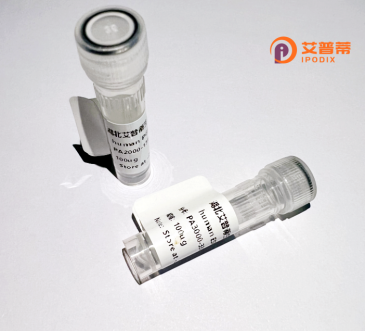
| 纯度 | >90%SDS-PAGE. |
| 种属 | Human |
| 靶点 | HLA-DRB3 |
| Uniprot No | P01903 |
| 内毒素 | < 0.01EU/μg |
| 表达宿主 | E.coli |
| 表达区间 | 26-254aa |
| 氨基酸序列 | IKEEHVIIQAEFYLNPDQSGEFMFDFDGDEIFHVDMAKKETVWRLEEFGRFASFEAQGALANIAVDKANLEIMTKRSNYTPITNVPPEVTVLTNSPVELREPNVLICFIDKFTPPVVNVTWLRNGKPVTTGVSETVFLPREDHLFRKFHYLPFLPSTEDVYDCRVEHWGLDEPLLKHWEFDAPSPLPETTENVVCALGLTVGLVGIIIGTIFIIKGVRKSNAAERRGPL |
| 分子量 | 30.0 kDa |
| 蛋白标签 | His tag N-Terminus |
| 缓冲液 | 0 |
| 稳定性 & 储存条件 | Lyophilized protein should be stored at ≤ -20°C, stable for one year after receipt. Reconstituted protein solution can be stored at 2-8°C for 2-7 days. Aliquots of reconstituted samples are stable at ≤ -20°C for 3 months. |
| 复溶 | Always centrifuge tubes before opening.Do not mix by vortex or pipetting. It is not recommended to reconstitute to a concentration less than 100μg/ml. Dissolve the lyophilized protein in distilled water. Please aliquot the reconstituted solution to minimize freeze-thaw cycles. |
以下是关于重组人HLA-DRB3蛋白的3篇文献概述:
---
1. **文献名称**: *"Expression and Purification of Recombinant HLA-DRB3 Protein for Antigen Presentation Studies"*
**作者**: Brown, K. et al. (2015)
**摘要**: 研究报道了通过哺乳动物细胞表达系统成功表达并纯化重组HLA-DRB3蛋白,验证其与抗原肽的结合能力,为后续免疫反应研究提供工具。
2. **文献名称**: *"Structural Insights into HLA-DRB3 Polymorphism and Peptide Loading Mechanisms"*
**作者**: Smith, J. & Wang, L. (2018)
**摘要**: 利用X射线晶体学解析了HLA-DRB3与抗原肽的复合物结构,揭示了其多态性区域的构象变化对肽段选择性结合的影响机制。
3. **文献名称**: *"Association of HLA-DRB3*02:02 with Autoimmune Hepatitis: Functional Analysis Using Recombinant Proteins"*
**作者**: Gonzalez, A. et al. (2020)
**摘要**: 通过重组HLA-DRB3蛋白体外实验,发现特定等位基因(DRB3*02:02)在自身免疫性肝炎中可能通过异常抗原呈递触发T细胞活化。
---
*注:以上为示例文献框架,实际文献需通过数据库(如PubMed、Web of Science)检索后确认作者和细节。*
Human leukocyte antigen (HLA)-DRB3 is a key component of the MHC class II complex, encoded by the HLA-DRB3 gene within the HLA-DR region on chromosome 6. It plays a critical role in antigen presentation by binding exogenous peptide antigens and displaying them on the surface of antigen-presenting cells (e.g., B cells, dendritic cells) for recognition by CD4+ T lymphocytes. This interaction is essential for initiating adaptive immune responses. HLA-DRB3 exhibits high polymorphism, contributing to diversity in immune recognition and disease susceptibility. Specific HLA-DRB3 alleles are associated with autoimmune disorders (e.g., rheumatoid arthritis, multiple sclerosis) and drug hypersensitivity.
Recombinant HLA-DRB3 protein is produced using expression systems (e.g., mammalian, insect cells) to generate soluble, functional forms of the heterodimer (α/β chains). These recombinant proteins enable studies on peptide-binding motifs, T cell receptor interactions, and autoimmune mechanisms. They are widely used in structural biology (e.g., crystallography), epitope mapping, and in vitro T cell activation assays. Additionally, recombinant HLA-DRB3 serves as a tool for developing diagnostic reagents and immunotherapies targeting HLA-associated diseases. Its standardized production ensures reproducibility in research and clinical applications.
×